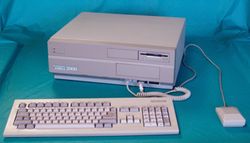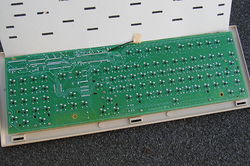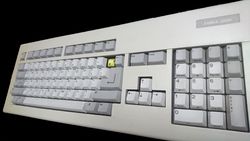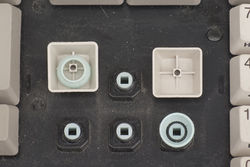Commodore Amiga 2000
 | |
| Part number | Cherry: G80-0879, G80-0904, G80-0922, G80-0924 |
|---|---|
| FCC ID | n/a |
| Branding | Commodore Amiga |
| Manufacturer | Cherry, Hi-Tek, Mitsumi |
| Features | NKRO |
| Layouts | 97/98 Key US, DE, DK, and many more |
| Keyswitches |
Cherry MX Black Hi-Tek Series 725 Mitsumi KKQ Type |
| Interface | Amiga proprietary |
| Price | n/a (included with System) |
The Commodore Amiga 2000 is a computer in the Commodore Amiga series. The Amiga 2000 is perhaps the Amiga model that has had the most keyboard revisions.
The keyboard's case design shares a common design language with the Commodore 64C, 128 and PC keyboards.
Contents
Keyboards
The connector is a 5-pin DIN plug. The pins are 1:Clock, 2:Data, 4:Ground, 5:+5V. Pin 3 in not used.[1]
Cherry versions
This keyboard (in a few variants) was the first generation of keyboards to ship with the Amiga 2000. It was also the first with the "full-sized" Amiga layout that was used later for all later models, except the (compact) Amiga 600. Among Amiga collectors, the keyboard fetches high prices and is highly sought after, due to its rarity. The keyboard was only in production for the first batch of Amiga 2000 computers (1986–1987)[Citation needed] and was later replaced by a more cost efficient foam and foil variant made by Mitsumi.
The Cherry keyboards are from Cherry G80 series, with Cherry MX switches and double-shot keycaps,[2] with a Cherry MX Linear Grey for the space bar. The Amiga keycaps are pad printed. Diodes are fitted for N-key rollover. The keycaps are originally featured a slightly lighter almond and light grey colour scheme than the default Cherry scheme.
These keyboards can be recognised by the gaps between the Amiga keys and the space bar.
The keyboard features a 1-unit windowed Caps lock key with a red LED beneath. The US variant has a "big-ass" Return key that mounts over two switches: the same as the ISO Return and the key next to it.
Disassembly
Two case variations have been identified: with either six clips or eight screws on the bottom side. Unfastening them should give access to the keyboard PCB inside. [3]
Gallery
Cherry MX Linear Grey under space bar. Note the lighter colour and diode
Known variants
- G80-0879HAU (US-layout, PCB-mounted MX blacks)[Citation needed]
- G80-0904HAD (DE-layout, PCB-mounted MX blacks)[Citation needed]
- G80-0922 (FI/SE-layout, PCB mounted MX blacks)
- G80-0924 (DK layout, PCB-mounted MX Black)
Hi-Tek version
The Hi-Tek keyboard used linear Hi-Tek Series 725 switches,[4] weighted at around 55 cN and with short key travel. The Amiga keys are black. There is a rivet that can be seen in the gap in-between the Del and Help keys. On some NMB keyboards, the left Amiga key has a Commodore logo on it instead of an italicized A. Some keyboards have switches with yellow sliders, others white.
Gallery
Mitsumi version
The Mitsumi version uses tactile Mitsumi KKQ Type switches with blue sliders. The keycaps were made from ABS and yellowed more easily than the earlier Cherry keycaps. Mitsumi keyboards can be told apart from the Hi-Tek keyboards by the decimal point on the numeric keypad not being aligned with the 0 key symbol's baseline, but being higher up.
To accommodate the integrated LED, the caps lock switch is linear.
Gallery
References
- ↑ Export Services! — Amiga Keyboard Pinouts
- ↑ English Amiga Board — Keyboard pictures — photo #3 actually shows double-shots keycaps
- ↑ hschid's blog — Amiga 2000A Tastaturen. Dated 2017-09-01. Retrieved 2018-04-16
- ↑ Reddit — Just got an Commodore Amiga 2000 Keyboard. What switches are those and how can I connect it to my pc?
- Pages with unreferenced claims
- Computers
- List of all keyboards
- Cherry G80 series
- Mitsumi OEM keyboards
- Hi-Tek OEM keyboards
- Cherry OEM keyboards
- Commodore keyboards
- Keyboards with Cherry MX switches
- Keyboards with Mitsumi hybrid switches
- Keyboards with Hi-Tek Series 725 switches
- Office keyboards
- Vintage keyboards
- Keyboards with NMB switches























